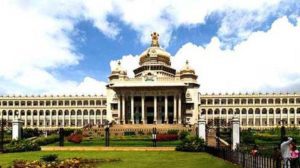Table of Contents
Nationwide National Register of Citizens (NRC) UPSC – IAS
The National Register of Citizens is a register of all Indian citizens whose creation is mandated by The Citizenship Act 1955 as amended in 2003. It has been implemented for the state of Assam between 2013–2014. The government plans to implement it for the rest of India in 2021.
- The National Register of Citizens is a list of all the legal citizens of the country, with necessary documents.
- Earlier, following the Supreme Court’s order, the Government conducted the NRC updating exercise in Assam and as a result over 19 lakh applicants failed to make it to the NRC list.
Rationale behind the nationwide NRC | UPSC – IAS
- Ascertaining the identity of citizens: NRC will provide a much-needed perspective on the extent of illegal migration. The fear that illegal immigrants will change the demography of the country and influence the politics of different states will also be done away with.
- Demand from some stakeholders- such as the NGOs like the Assam Public Works (APW), which had petitioned the Supreme Court for upgrading the previous NRC.
- Statutory obligation of the state- as the Section 14A in the Citizenship Act of 1955 provides in sub-section (1) that “The Central Government may compulsorily register every citizen of India and issue national identity card to him”.
- The procedure to prepare and maintain National Register of Indian Citizens (NRIC) is specified in the Citizenship (Registration of Citizens and Issue of National Identity Cards) Rules, 2003.
- Move towards solving the immigration issue- as it is expected to deter future migrants from entering the country.
- It can also aid the agencies in effective border management, especially with Nepal and Bangladesh.
Issues with nationwide NRC | UPSC – IAS
- Existence of deportation provisions- as immigrants are subject to laws like the Foreigners Act, 1946 and Passport (Entry into India) Act, 1920 and tribunals are already empowered to detect, detain and deport them.
- Legal infirmities- The last time the Central government tried to make an identity enrolment mandatory was the Aadhaar project and this was struck down as excessive (except in limited and justifiable cases). The NRIC scheme, as proposed, would thus be directly in violation of the K.S. Puttaswamy judgment on right to privacy.
- Not learning from Assam’s experience- considering the complications that have cropped up in the previous NRC such as-
- No clarity over previous results- on what the end results mean for the 19 lakh plus people who find them outside the NRC, potentially stateless and at risk of “deportation” to Bangladesh, which refuses to acknowledge the same.
- Wastage of public resources- as many critics are questioning the expenditure of the taxpayers’ money which were spent on the previous NRC.
- Lack of capacity- Assam’s first detention centre is being constructed, but it will only house 3,000 people against the need for 19 lakh people excluded from the final NRC. Further, media reports have been stating that these detention camps are infamous for their inhumane living conditions.
- Protests- Many sections of Assam, like Bodoland students, have been protesting against the repetition of NRC in Assam.
- Concerns of minorities: There are fears that such an exercise could end up targeting minorities in the country.
- The Citizenship (Amendment) Act, 2019 which makes Hindu illegal migrants and those from certain other minority communities in Afghanistan, Bangladesh and Pakistan eligible for Indian citizenship further creates apprehensions about alienation of minorities in the process.
- Implementation anomalies- as the NRC will take a gigantic toll on people’s time, money and productivity, especially of the poor and illiterate sections.
- Under the Foreigners Act of 1946, the burden of proving whether an individual is a citizen or not, lies upon the individual applicant and not on the state. Also, the details of how such an exercise will be carried out are not yet known.
- Further, there is poor documentary culture in India and here around 125 crore Indians will have to produce documentary proof of their ancestors up to a certain date to create a legacy tree.
- No specific policy in ascertaining the fate of people: The government has not prepared a post NRC implementation plan, as the possibility of deportation of illegal migrants to Bangladesh is bleak as the people excluded from the list should be proven citizens of Bangladesh, and that will require cooperation from that country.
- Allegations of human rights violations- as at a US Congress hearing on human rights in South Asia, not just Kashmir issue was raised but Assam’s NRC also came up.
- Issue of Statelessness: There are apprehensions that India will end up creating the newest cohort of stateless people, on the lines of Rohingyas who fled Myanmar for Bangladesh.
A Way Forward | UPSC – IAS
- Set a common Cut-off date to maximum two generations – which will ease up the process for citizens to show documentary proofs.
- The problem in Assam was the cut-off year of 1971, which made it near impossible for many to get documents that went so far back in the past.
- The NRC should attempt to prevent further arrivals of illegal migrants. Past arrivals cannot easily be wished away without causing needless human misery and also disrupting micro-economies in the states where the illegals reside and work.
- Synchronize NRC with Census 2021- as much as possible, as the Census 2021 will kick off from September 2020, there is enough time to tell people to get their documents ready and hand them over for verification to census workers, who can then remit them to the designated tribunals or benches that look into the validity of the documents.
- Bring a fair process- There were allegations that some sections had submitted false documents during Assam’s NRC exercise. A nationwide NRC is expected to learn from this.
- Tackle issue of illegal migration comprehensively- by focussing on comprehensive border management, assistance from international organisations such as United Nations High Commissioner for Refugees (UNHCR) among others.
- Government of India can work with other governments to get authenticated copies of their own voter and citizenship records. This can be done under a large SAARC convention too.
- Maximize use of technology- such as utilization of digital lockers. Citizens should be told get all their documents authenticated in digital lockers, so all they would need to do is provide access to this documentation when the NRC happens.
- By appropriately using artificial intelligence and data analytics, governments can match residents suspected of being immigrants fairly easily using multiple databases.




